.jpg)
Hans Op de Beeck. Photo: Christophe Vander Eecken, 2014.
by ANNA McNAY
Hans Op de Beeck (b1969, Turnhout, Belgium) is a visual artist working across a variety of mediums. Danse Macabre, his sculptural installation for this year’s Triennial Bruges, which takes the theme of TraumA, is a life-size, monochromatic grey carousel, being ridden by skeletons, and standing in the shadow of the baroque facade of St Walburga church. With a very busy year ahead – partly as a result of postponements due to Covid – Op de Beeck is working simultaneously on an opera, a number of major institutional exhibitions and an enormous immersive installation for the Lyon Biennale 2022.
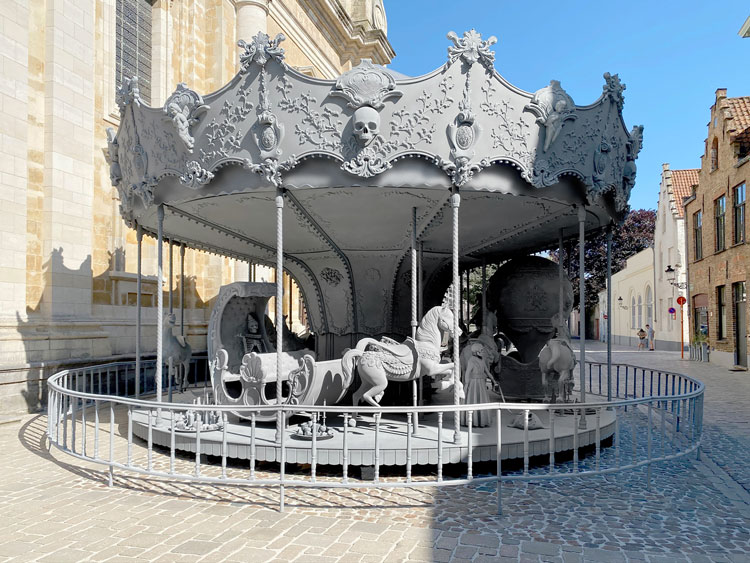
Hans Op de Beeck, Danse Macabre, 2021. Sculptural installation: steel, aluminium, wood, polyester, polyamide, polyurethane, PVC coated nylon, plaster, coating, 950 x 650 x 950 cm. Photo: Studio Hans Op de Beeck, 2021.
Amid all this preparation, Op de Beeck spoke to Studio International via Zoom about his special-formula grey paint, the absurd tragicomedy of the carousel, the importance of revealing all elements of construction in a work, and the therapeutic or cathartic effect of making art.
Anna McNay: Tell me a bit about the idea behind Danse Macabre. Is there any specific link to the theme of this year’s Triennial Bruges – TraumA? And, if so, do you want this to be explicit, or, as I have read, do you seek to incorporate such references in a subtle and discrete way, along with references to things of yesterday, so as not to come across as a judge?
Hans Op de Beeck: The theme of the triennial is, as you say, TraumA, and, since the curator is German speaking, this includes every word that you can find within it, as well. There’s Raum, which means room or space; there’s Traum, which means dream, and, of course, there’s trauma itself, which, I think, is a word that exists in many languages. We all know Bruges as a fully restored, cleaned-up tourist city, but not everything is as authentic as it looks. It’s cute, and it’s well done, and you can have a nice weekend there. What I liked about the curatorial idea this time was that they said: “Well, it’s all well and good that Bruges is such an idyllic setting, but, of course, behind the scenes there is the history. So many things happen behind closed doors, and we would like to talk about both the dream and the nightmare, let’s say, or the fancy, ornamented side, on one hand, but also the dark, mysterious, problematic and traumatic side of things.”
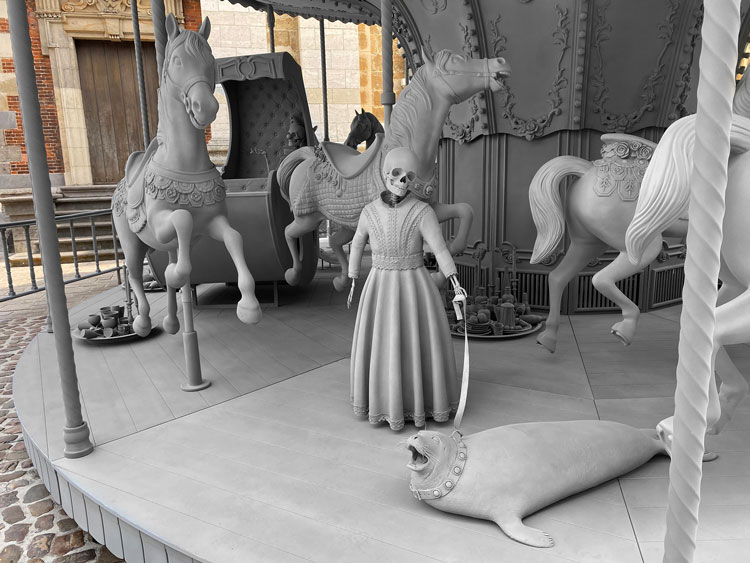
Hans Op de Beeck, Danse Macabre, 2021. Sculptural installation: steel, aluminium, wood, polyester, polyamide, polyurethane, PVC coated nylon, plaster, coating, 950 x 650 x 950 cm. Photo: Studio Hans Op de Beeck, 2021.
I have always considered a merry-go-round a pompous, kitsch object that you can still find at every fair. You see them everywhere. They’re an international cliche. All my kids have been on one; I have been on one; everyone has. Recently, I was in Florence with my youngest, and he rode on one again. It was all pink, silver and gold, covered in ornamentation, and nothing about it was authentic. The horses looked as if they had been carved out of wood 100 years ago, but it was an illusion. They have this Viennese, festive character, and I adore them. I have no problem in admitting that there’s a lot of kitsch I like. So, to counter the clean and tidied-up image of Bruges, I thought I would produce a merry-go-round, which is normally so colourful, in monochromatic grey, so that it looks a bit as if it’s covered with ash, or maybe petrified, frozen in time, not moving anymore.
This kind of afterimage is a notion that I use a lot in my work. It is more about how light defines shadows and bright parts and evokes a mood. It’s not about simulation. If I were to simulate a merry-go-round, I would make a real one with all the colours and everything that goes with that. Quite a lot of my installations are achromic: black, white or grey. It’s a bit like the abstraction that you get with black-and-white photography, where it’s not about simulating reality, or colour, but more about trying to grasp something essential. By taking away the distraction of colour, you can focus on what’s underneath. And I took that quite literally with Danse Macabre, with the skeletons. I was also thinking about the Belgian painter James Ensor, who, 100 years ago, was making very festive paintings with skeletons celebrating, getting drunk, smoking, cracking jokes, things like that. I thought: “Why not make a gigantic memento mori?” I didn’t want it to have a gothic or Halloween look, but rather something that looks a bit like an abandoned object that lost all its colour, fell asleep, or got frozen in time.
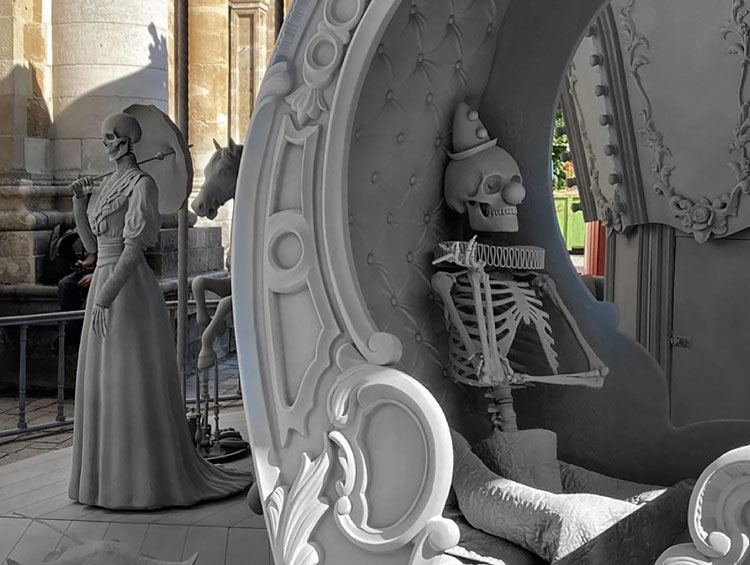
Hans Op de Beeck, Danse Macabre, 2021. Sculptural installation: steel, aluminium, wood, polyester, polyamide, polyurethane, PVC coated nylon, plaster, coating, 950 x 650 x 950 cm. Photo: Studio Hans Op de Beeck, 2021.
AMc: What is Danse Macabre made of?
HOdB: It’s made of metal, wood, polyester – all kinds of materials. Over the years, I have developed my own kind of paint, which, when you spray paint it in the way I do, in multiple layers, looks a bit as if it were not just a coating on top, but as if the object were entirely made of that grey. It’s something I have researched, because, about 10 years ago, I made quite a few plaster sculptures, where I would mix black pigment in with the plaster. When it dried, it turned grey. I liked this because, when you have a sculpture that’s entirely white, it’s a bit too neat and very hard to read the shape and to understand. Especially when, for example, you sculpt a man, woman or child. When it’s entirely white, it’s hard to figure out the details, but when it’s grey, you apparently solve the problem. That’s something I’ve learned through doing.
The soft grey tone really articulates a face, a hand, an arm or an ornament quite beautifully. I developed it in such a way so that it’s super matte, totally non-glossy. It has this velvet kind of skin, which very softly bounces back the light. It’s something I love as a way of also immediately and straightforwardly telling the spectator: “Look, this is just a sculpture.” If I were to make, let’s say, a human being in full colour, it would be like a Madame Tussauds sculpture, and I don’t see the point in doing that, with all due respect to Madame Tussauds. Simulation is not interesting for me as a figurative artist. I’d sooner speak about interpretation and evoking a mood, rather than trying to painstakingly copy reality. For example, in the 70s, we had all those hyper-realistic painters who painted so you couldn’t tell whether it was a photograph or a painting. I think: “Why bother?” Just show the photograph, if it’s a good one. Whether I’m writing a character – because I have started to direct some theatre – or sculpting one, it’s really about trying to grasp something of what is underneath the surface.
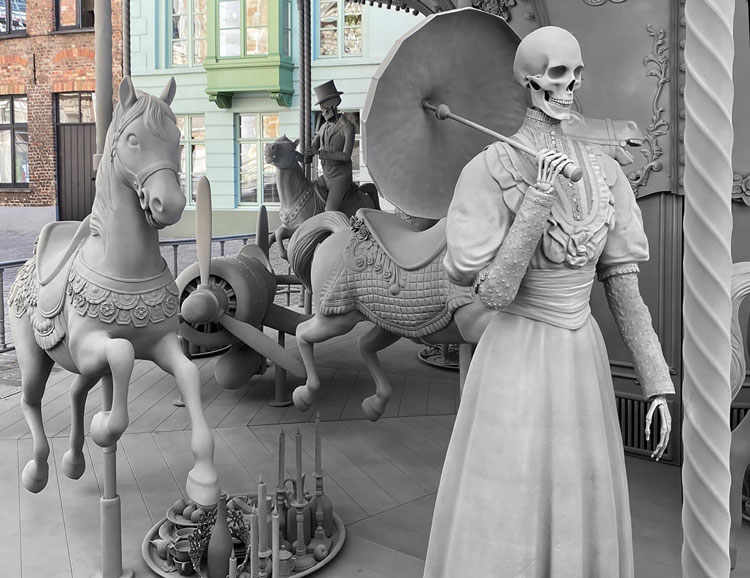
Hans Op de Beeck, Danse Macabre, 2021. Sculptural installation: steel, aluminium, wood, polyester, polyamide, polyurethane, PVC coated nylon, plaster, coating, 950 x 650 x 950 cm. Photo: Studio Hans Op de Beeck, 2021.
Maybe this is also why I love fiction so much more than historical novels, where the author is trying to prove his or her knowledge of history. It’s great that people know a lot of facts about the past, but whether or not something is historically correct in the visual arts, or in theatre, or in novels – I don’t need that because it smells a bit of legitimation. “Yeah, but it’s a true story.” Then I think: “Well, I don’t care.”
I also currently have a sculpture on show in the Hermitage Museum in St Petersburg. It’s a life-size, fictitious character on a horse, and he looks like a loner, a refugee, a very mysterious, enigmatic, strange man, with a little monkey on his shoulder who collects all kinds of strange objects. I have no legitimation, such as this referring to such and such a myth, or my objects being historically correct. I don’t care about that. I’m much more interested in trying to find a balance concerning what we can accept as true. It’s about the suspension of disbelief and how far you can take a spectator into something that is undeniably fake but contains something that feels authentic. It’s like when you’re moved by a character in a novel. You don’t then think: “Yeah, but this is nonsense. This is made up by an author.” You totally forget you’re holding a book in your hand, and you’re just there with the emotion, and you can be as profoundly moved by this fictitious character as by your own child.
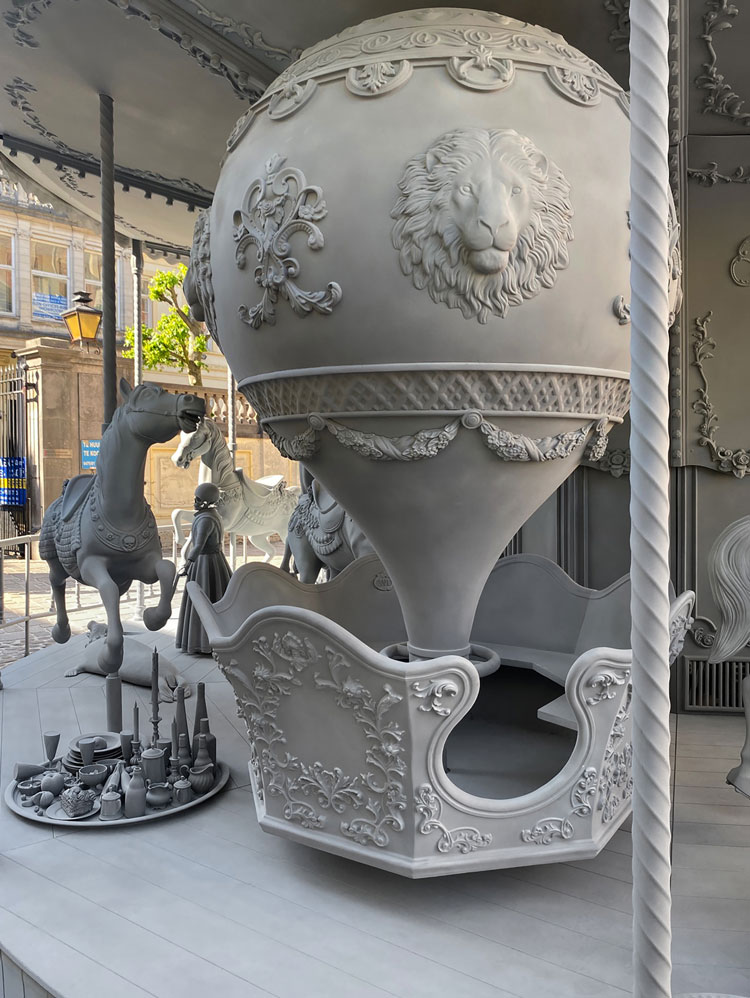
Hans Op de Beeck, Danse Macabre, 2021. Sculptural installation: steel, aluminium, wood, polyester, polyamide, polyurethane, PVC coated nylon, plaster, coating, 950 x 650 x 950 cm. Photo: Studio Hans Op de Beeck, 2021.
AMc: Presumably when you’re writing for the theatre, in a shade of grey, it is nevertheless ultimately going to be a full-colour production? Would you see that only as being the result of the viewer adding his or her interpretation, though?
HOdB: Yes. I always like it best when you don’t try to suggest that something is real. I have also made some films, called Staging Silence, which I made on a tiny film set, and there are two pairs of hands constructing and deconstructing fictitious landscapes and interiors. You see those hands coming in and out all the time, so you know that it’s just some crap on a one-square-metre filmset, yet you’re invited to give credibility to it, to believe in it, and to be transported into this parallel world, which somehow resonates with the world as we know it. Whether it’s moving image, sculpture, or something as ephemeral as theatre, which has this here and nowness, I would never try to hide the construction. When we’re receptive to it, we can find an authentic experience in it.
AMc: You’ve described the carousel elsewhere as being “absurd” and “tragicomic”, as something you put your child on which just goes round and round in circles. It’s almost like a metaphor for the world itself, and for those days when you just want to yell: “Stop! I want to get off!” Is there a sense of that in the work? Do you see it as a metaphor for life or the world, particularly right now with the pandemic?
HOdB: I’m happy you used the word “metaphor” and not “symbol”, because I like an image that refers to another image or to another meaning. Sometimes people ask me: “Is this a symbol for that or for that?” But I don’t like symbols. I don’t want to do symbols. Symbols are too broad and too general, so, ultimately, they don’t say anything anymore. But, indeed, a merry-go-round has that same sense as being on a treadmill. Do we stay on it, or do we get off? I like the idea that you call it a metaphor or metaphorical construction. I think it was Nietzsche who said that language is always metaphorical – every word is a metaphor – and that’s true as well.
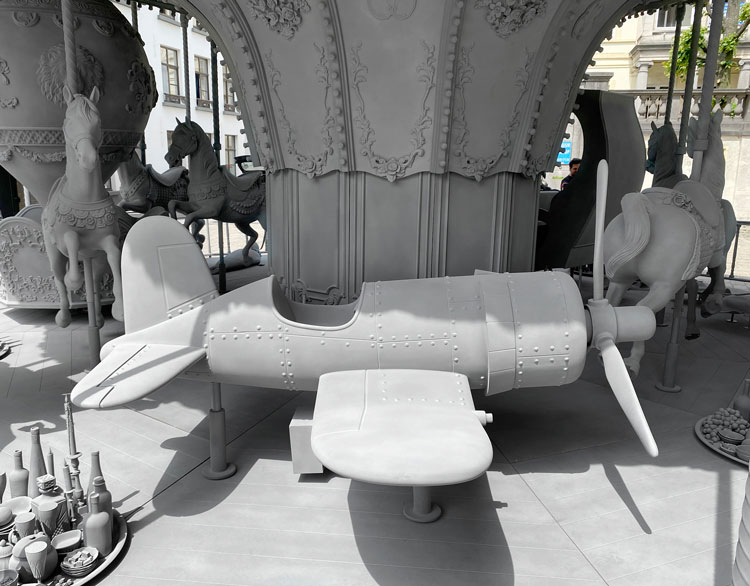
Hans Op de Beeck, Danse Macabre, 2021. Sculptural installation: steel, aluminium, wood, polyester, polyamide, polyurethane, PVC coated nylon, plaster, coating, 950 x 650 x 950 cm. Photo: Studio Hans Op de Beeck, 2021.
AMc: What about the title, since you mention language? Danse Macabre carries a lot of associations, being a genre in its own right, both in music and art.
HOdB: I have to give all credit to my assistant and studio manager, Ann Marcelis, because, when I can’t think of a title, I ask for her help. She suggested Danse Macabre, and I thought it was a brilliant idea. Normally, I’m not such a meta-artist. I think I have only made one photographic work where I refer to a painting by Manet in the title. People sometimes ask me which artists inspire me, but I simply start from daily life. I’m also a big admirer of many artists such as the Coen Brothers in cinema; Raymond Carver as a writer; Arthur Miller as a playwright; and Peter Doig as a painter – and his work is extremely colourful and totally different from mine. I would not say that such people inspire me directly, but, of course, as a spectator, I love to consume, to appreciate and to incubate what others make. When you make art, it’s good to be aware of what’s going on, or what has gone on in the past, but this title refers to a lot of colleagues in other disciplines who use it. It absolutely makes sense for this work.
.jpg)
Hans Op de Beeck, Danse Macabre, 2021. Sculptural installation: steel, aluminium, wood, polyester, polyamide, polyurethane, PVC coated nylon, plaster, coating, 950 x 650 x 950 cm. Photo: Studio Hans Op de Beeck, 2021.
AMc: You have mentioned some of your work in various other genres already, and you have even done opera, if I am not mistaken.
HOdB: Yes, I’m currently working on a new opera composed by Wim Henderickx. The libretto is based on the novel The Convert by Stefan Hertmans. I will be doing the stage directing, the scenography and the costumes for the production. But, of course, there I’m the one who has to serve the composer in the first instance. I have to give him and the performers the best possible visual world, but it’s not my work. I have started to write and direct theatre, as well, and that’s closer to my visual arts work, in the sense that I write a text, I direct it, and I do the scenography and costumes for it. It has a feel of the Gesamtkunstwerk, where all the disciplines are mingled. It is something I love to do and about which I still have a lot to learn. Especially now for the opera, which will be a production of two and a half hours, with 77 people on stage – it’s going to be very challenging.
Even there, though, I’m celebrating and honouring the same principles. I’m not trying to pretend that the opera house is not an opera house. It is an opera house. It is a stage. It is a staged situation. During the opera, the technicians will be on stage changing the set all the time. It’s not done in a hidden way, everything is shown. It’s as if the technicians were some sort of masters of ceremony, or people that take care that everything happens correctly. They’re dressed in black, and they’re calmly changing the set all the time you’re watching the opera. I thought it was a nice idea that the transformation would be ongoing.
Maybe another thing I could mention in relation to Danse Macabre is that, as a spectator and as an artist, I like calm and tranquillity as a mediator to talk about things that are more profound, that are underneath the surface or in between the lines. Being loud and spectacular is not difficult; it’s more difficult to deliver something in a quiet way. That’s a bigger challenge and, at the same time, it’s also something I appreciate a lot more as a spectator. When something tragic is delivered in a calm and “small” way, it speaks more strongly than when it’s shouted at me.
AMc: It makes people more willing to engage and think, rather than just feel they’re being told, I think.
HOdB: Exactly. That’s a very good remark, because I’m always afraid that I might come across as saying: “I know better. I’m an artist.” Which is total nonsense. I’m just a clumsy human being, and I make mistakes constantly. From some I learn, and from others I don’t. There’s quite a lot of preaching to the choir in the arts. If you make a visual artwork about the refugee crisis, for example, you’re talking to people who are already aware of it, so it’s not as if you’re going to change opinions. I think, in such an instance, you should make a documentary instead.
I think a lot about these things. I never pretend I have any wisdom to share, because I don’t. I have the same questions as everyone else. Maybe what I try to say with my work is that the spectator is not alone in this struggle, that I also have these ethical problems, and that I also have these obstacles I have to find a way to overcome. I think art, at its best, is something that is consoling, like a hand on your shoulder. And then the age-old idea of catharsis that helps you to purify, to clean up your thoughts, and to feel that you’re not alone with the human condition. This is what I’m trying to find, and it can be as simple as something that is pure, beautiful and quiet. It doesn’t have to have a shocking or irritating edge. It can go from something very aesthetically beautiful to something really deep and dark – and everything in between. I also don’t think we should state: “Art should do this” or “Art should do that.” No. I just try to formulate for myself. But I’m trying to find out how I can be the best version of myself in what I do. I can only strive to become a better Hans Op de Beeck. I will never be a brilliant Anish Kapoor, for example. I can never deliver something that is not mine, or which doesn’t depart from my own limited background or my own subjective voice.
Coming from a graphic novel background, with comic books and things full of detail, at some point I tried to be more minimal, because that was what was going on in contemporary art when I was studying. Then I learned that maybe I’m just the kind of person who loves to put in detail and who loves to make things more elaborate; that I don’t necessarily agree with the idea that less is more. At some point in my career, I gave up trying to be artistically correct and decided to make what I wanted to make and not self-censor too much.
That’s also the advice I always give to students at art colleges and universities. I always encourage them, and I tell them: “Please be stubborn and keep your own voice.” It’s like when you write a novel: don’t try to write a novel, just try to tell a story. Don’t think too much about the formal aspects of it, and how others will judge it, because then you will just block yourself. Many of the students I have taught have had times when they have been totally blocked, and I always told them: “It doesn’t matter.” Sometimes, to challenge them, I would say: “You don’t even need content for your work. You don’t need a subject. Just make something, and the subject will appear.” I gave the example, a couple of times, of Giorgio Morandi, who made many paintings of just a couple of bottles on a tabletop. If he were an art student today, most probably his teachers would say: “Isn’t that old fashioned and a bit boring? I don’t see any link with the world today. Where is your reflection on the world on fire?”
AMc: Or “Where is the concept?”
HOdB: Exactly. “Where’s the concept?” While, of course, the work is brilliant because, in its simplicity, it talks about the world. It talks about melancholy. It talks about extreme silence. It’s like an incredibly reduced still life, which somehow represents the human condition. When it’s executed in the way Morandi did it, it works. I love it that you can turn something, which seemingly doesn’t have any content, into content, and into very contemporary content. I’m not pleading to have all artworks in a very simplified form, or saying we should all become Morandis, of course not. I love people who have a very political voice. I love people whose works are totally abstract. I love people who work with crap, such as Thomas Hirschhorn. And I love people who have worked, in the past, in a very sterile way, such as Donald Judd. It’s all great, because there is a preciseness in the balance between form and content. In that regard, as a maker and as a spectator, I’m very eclectic. I can appreciate anything. Your receptiveness broadens as you get older, I think. This also made me realise that, even if something I make is not artistically correct for some, it will be for others. You can’t please everyone with what you do, and that should also not be your goal. I think the biggest concern is that whatever you do, you should do it with complete dedication.
AMc: Because if you’re trying to please everyone, you’ll end up pleasing no one.
HOdB: Exactly. I think the world would be a better place if we would all do what we feel like doing, but with complete dedication. It makes me very sad when I go to a flower shop, for example, and the flowers are just randomly put together. Another day, I might go and see that someone has really created something special with the flowers. That’s what we can do in this ridiculously short life. That’s the difference we can make: do something with complete dedication, whatever it is.
AMc: You have touched on this already, but, in your artist statement, you say that you’re seeking to create “a form of visual fiction”.
HOdB: Yes. With “visual fiction” I mean, as I was trying to explain before, that, for me, it doesn’t make any sense to deny that something is fictitious. Anything I do, whether it’s a short story, a play, a piece of music, a sculpture or a watercolour painting, is all nonsense. That’s what I mean by “fiction”. It is fiction as one would meet it in a novel, for example, but a visual version of that. An author of a novel invites you to join in with his or her nonsense, and, when you do, and when you’re receptive towards it, it becomes real, it becomes something authentic. This is what is so beautiful about the arts. When you’re receptive to them, you can live three lives in one go, because you can be moved by your child, by your mum and by a fictitious character in a novel.
AMc: It’s a way of escaping your own life.
HOdB: And that’s beautiful.
AMc: You have talked a bit about trauma, and you mentioned catharsis, which obviously is going to come up in relation to trauma. When you talked about art as being cathartic, you were talking more, I think, from the point of view of the viewer, but do you see it as such from the point of view of the artist as well?
HOdB: Yes, absolutely. There are a lot of artists who oppose the idea that creating art is some sort of a therapy, but of course it is. I mean, really, do we have to disagree on that? I don’t think so. Of course, when something is only therapy, it’s not enough. But when you are an artist, you have to deliver more, you have to go further. And this additional quality of the artwork, compared to just an artefact, is something truly important. But you cannot deny the therapeutic aspect of and for an artist making his or her work. It’s a way to deal with the world. It’s a way to digest the world. It’s a way to communicate about the world. It’s a way to form an identity. It’s a way to share. It’s a way to process feelings. It’s a way to console others. But, in the first place, I would say, as an artist, you make something, and, in making, it is healing you, because it’s a constructive act. In the first place, you console and heal yourself, and, by doing so, with complete dedication and a certain degree of talent, you can also share this with others.
When you talk about catharsis, I remember, for example, Breaking the Waves, a movie by Lars von Trier, where the protagonist of the story is such a profoundly moving, tragic character. When you live with her, when you go through what she goes through as a fictitious character in the movie, it’s exhausting, but, at the end of the movie, it’s such an enriching feeling. When you then leave the cinema, you look at the world through different eyes. I think that’s what art does. It’s like when you finish a novel and pity the fact that it’s over.
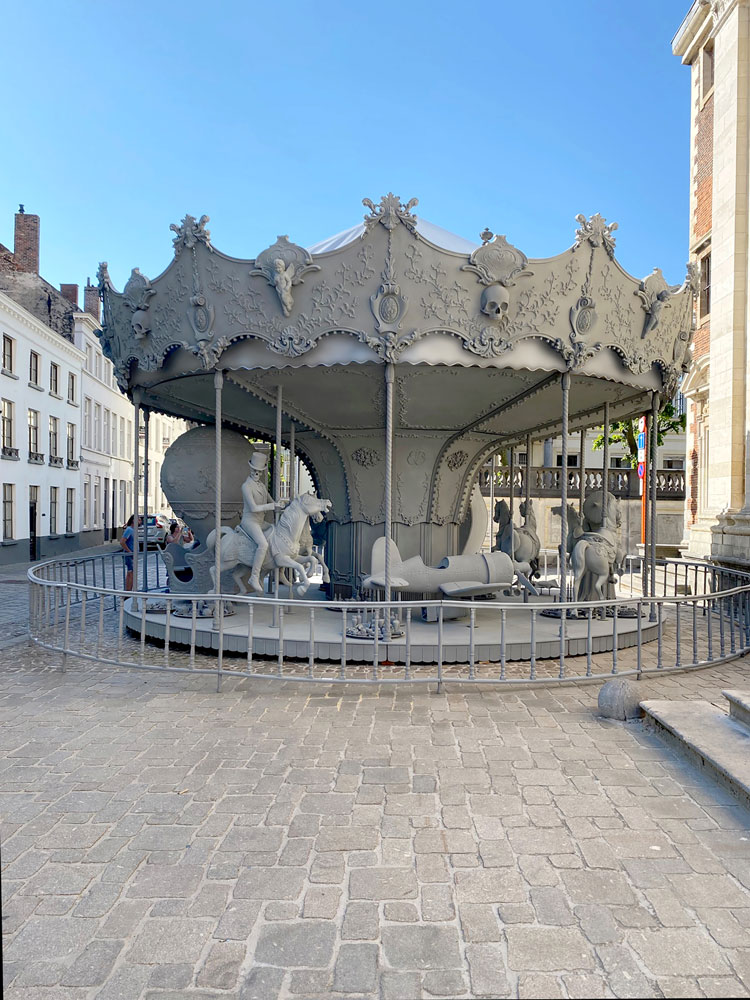
Hans Op de Beeck, Danse Macabre, 2021. Sculptural installation: steel, aluminium, wood, polyester, polyamide, polyurethane, PVC coated nylon, plaster, coating, 950 x 650 x 950 cm. Photo: Studio Hans Op de Beeck, 2021.
AMc: Speaking of endings: What will happen to Danse Macabre once the triennial is over? Where will it go then?
HOdB: In 2022, I have a solo exhibition at the Amos Rex Museum in Helsinki, and the merry-go-round will be part of that. It’s an enormous, open space – very landscape-like, you could say. I believe it’s almost 2,000 square metres. I will try to create a large immersive installation, which the merry-go-round will be part of, and you will meet many other things in that strange, fictitious garden. I’m trying to conceive that show as one enormous, deserted, handcrafted filmset, or a depopulated, deserted space. You’ll meet characters and objects of all sizes – a bit like Alice in Wonderland.
AMc: I don’t want you to give all your secrets away, but will that be monochrome as well?
HOdB: It will be black, white and grey, but there will be some colours as well. I did an installation at the Setouchi Triennale in Japan, where I had a black, white and grey world, but I inserted sculptures of blossom trees with totally over-the-top pink, which became even more over the top because of all the rest being black and white. It’s really interesting to combine some colours with an otherwise achromic world. It’s like when you have a monochromatic painting, and you add a couple of touches of colour, and they stand out so strongly because all the rest is so silent.
AMc: Is this solo exhibition what you are working on at the moment?
HOdB: Yes, but there is also a show in Moscow, and, actually, it’s really piling up. First, I have a project at Musée de l’Armée in Paris, an immersive installation which will now open in October. Then, in 2022, I have the big opera production, but also a lot of exhibitions because everything got postponed due to Covid. My team and I are facing an incredibly packed year, full of institutional shows, with a lot of space to be filled. I’m also participating in the Lyon Biennale in France. Again, I will be making an enormous, immersive installation.
I have to give my compliments to the curators of the Triennial Bruges, though, because they kept it quite modest. I like that a lot. There were some years when I participated in the Venice Biennale, for example, but only went to visit a couple of things. Many biennials or triennials just lead to a sort of art tourism. People have their list with 45 venues they have to visit and tick off. I really oppose this, both as an artist, but also as a teacher in art schools and universities. For example, I was a teacher at the art college in Brussels when I was doing my PS1 residency in New York, and I took my students to New York and told them to do just one thing a day. When I was studying art, my teachers took me to a million things in one day, which is totally the wrong approach, I think.
AMc: You don’t take any of it in that way.
HOdB: Exactly. You don’t digest it, and it’s totally the wrong way of looking at art. This is what I love about the approach of the Triennial Bruges. It’s very manageable. You can walk from one thing to the other, and it’s not too much.
I also like it when a museum is not too enormous. If you go to the Louvre, it’s depressing. As an art lover, of course, you want to see it all, but it’s simply impossible. You would need weeks. That’s why I like the concept of a Kunsthalle so much, because you go, and there is just one show, and you can easily digest it, and that’s your day. You don’t have the frustration of: “I should have visited all the other galleries as well.”
It’s the same with my art practice. Of course, I want to continue to work with the wonderful people I work with, there’s no doubt, but, in the past, I have worked alone, and the very root of my art practice is about making things, regardless of the setting or the surroundings. It’s not a business structure. When I did the PS1 programme, I was in a very tiny studio in a clocktower building in Tribeca. I went to Canal Street and bought drawing paper, and I was basically making drawings all the time, because that was what I was able to do in those circumstances. I made one video, I have to admit, but, apart from that, it was just small drawings. And it was lovely. It doesn’t make you any less satisfied with your practice when it’s on a smaller scale. It doesn’t make it any less intense. It’s not about how big or complicated things are, it’s really about what you are trying to say, and that could be through a small drawing just as successfully as through a large, immersive installation.
• Triennial Bruges 2021: TraumA runs at various locations around the city until 24 October 2021.